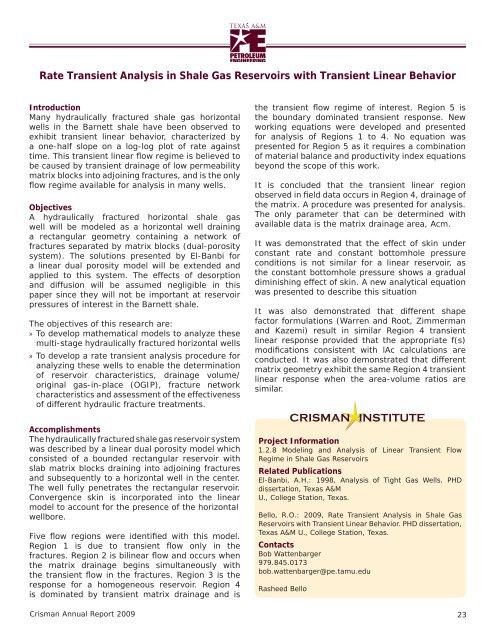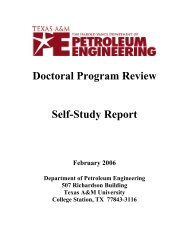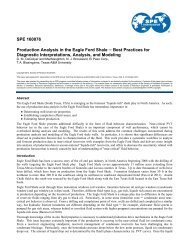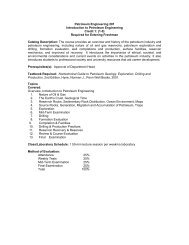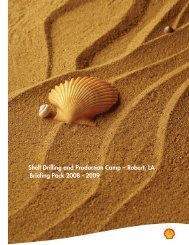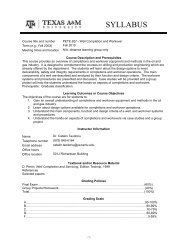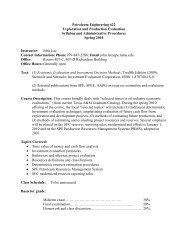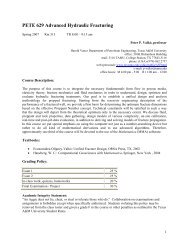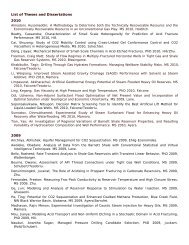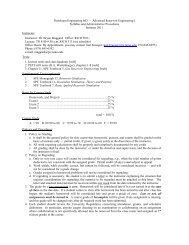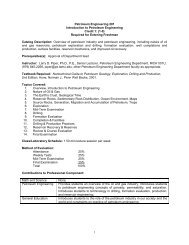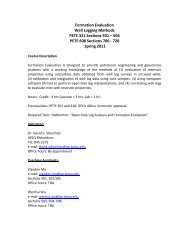Crisman Annual Report 2009 - Harold Vance Department of ...
Crisman Annual Report 2009 - Harold Vance Department of ...
Crisman Annual Report 2009 - Harold Vance Department of ...
You also want an ePaper? Increase the reach of your titles
YUMPU automatically turns print PDFs into web optimized ePapers that Google loves.
Rate Transient Analysis in Shale Gas Reservoirs with Transient Linear Behavior<br />
Introduction<br />
Many hydraulically fractured shale gas horizontal<br />
wells in the Barnett shale have been observed to<br />
exhibit transient linear behavior, characterized by<br />
a one-half slope on a log-log plot <strong>of</strong> rate against<br />
time. This transient linear flow regime is believed to<br />
be caused by transient drainage <strong>of</strong> low permeability<br />
matrix blocks into adjoining fractures, and is the only<br />
flow regime available for analysis in many wells.<br />
Objectives<br />
A hydraulically fractured horizontal shale gas<br />
well will be modeled as a horizontal well draining<br />
a rectangular geometry containing a network <strong>of</strong><br />
fractures separated by matrix blocks (dual-porosity<br />
system). The solutions presented by El-Banbi for<br />
a linear dual porosity model will be extended and<br />
applied to this system. The effects <strong>of</strong> desorption<br />
and diffusion will be assumed negligible in this<br />
paper since they will not be important at reservoir<br />
pressures <strong>of</strong> interest in the Barnett shale.<br />
The objectives <strong>of</strong> this research are:<br />
» To develop mathematical models to analyze these<br />
multi-stage hydraulically fractured horizontal wells<br />
» To develop a rate transient analysis procedure for<br />
analyzing these wells to enable the determination<br />
<strong>of</strong> reservoir characteristics, drainage volume/<br />
original gas-in-place (OGIP), fracture network<br />
characteristics and assessment <strong>of</strong> the effectiveness<br />
<strong>of</strong> different hydraulic fracture treatments.<br />
Accomplishments<br />
The hydraulically fractured shale gas reservoir system<br />
was described by a linear dual porosity model which<br />
consisted <strong>of</strong> a bounded rectangular reservoir with<br />
slab matrix blocks draining into adjoining fractures<br />
and subsequently to a horizontal well in the center.<br />
The well fully penetrates the rectangular reservoir.<br />
Convergence skin is incorporated into the linear<br />
model to account for the presence <strong>of</strong> the horizontal<br />
wellbore.<br />
Five flow regions were identified with this model.<br />
Region 1 is due to transient flow only in the<br />
fractures. Region 2 is bilinear flow and occurs when<br />
the matrix drainage begins simultaneously with<br />
the transient flow in the fractures. Region 3 is the<br />
response for a homogeneous reservoir. Region 4<br />
is dominated by transient matrix drainage and is<br />
<strong>Crisman</strong> <strong>Annual</strong> <strong>Report</strong> <strong>2009</strong><br />
the transient flow regime <strong>of</strong> interest. Region 5 is<br />
the boundary dominated transient response. New<br />
working equations were developed and presented<br />
for analysis <strong>of</strong> Regions 1 to 4. No equation was<br />
presented for Region 5 as it requires a combination<br />
<strong>of</strong> material balance and productivity index equations<br />
beyond the scope <strong>of</strong> this work.<br />
It is concluded that the transient linear region<br />
observed in field data occurs in Region 4, drainage <strong>of</strong><br />
the matrix. A procedure was presented for analysis.<br />
The only parameter that can be determined with<br />
available data is the matrix drainage area, Acm.<br />
It was demonstrated that the effect <strong>of</strong> skin under<br />
constant rate and constant bottomhole pressure<br />
conditions is not similar for a linear reservoir, as<br />
the constant bottomhole pressure shows a gradual<br />
diminishing effect <strong>of</strong> skin. A new analytical equation<br />
was presented to describe this situation<br />
It was also demonstrated that different shape<br />
factor formulations (Warren and Root, Zimmerman<br />
and Kazemi) result in similar Region 4 transient<br />
linear response provided that the appropriate f(s)<br />
modifications consistent with lAc calculations are<br />
conducted. It was also demonstrated that different<br />
matrix geometry exhibit the same Region 4 transient<br />
linear response when the area-volume ratios are<br />
similar.<br />
Project Information<br />
1.2.8 Modeling and Analysis <strong>of</strong> Linear Transient Flow<br />
Regime in Shale Gas Reservoirs<br />
Related Publications<br />
El-Banbi, A.H.: 1998, Analysis <strong>of</strong> Tight Gas Wells. PHD<br />
dissertation, Texas A&M<br />
U., College Station, Texas.<br />
Bello, R.O.: <strong>2009</strong>, Rate Transient Analysis in Shale Gas<br />
Reservoirs with Transient Linear Behavior. PHD dissertation,<br />
Texas A&M U., College Station, Texas.<br />
Contacts<br />
Bob Wattenbarger<br />
979.845.0173<br />
bob.wattenbarger@pe.tamu.edu<br />
Rasheed Bello<br />
CRISMAN INSTITUTE<br />
23


